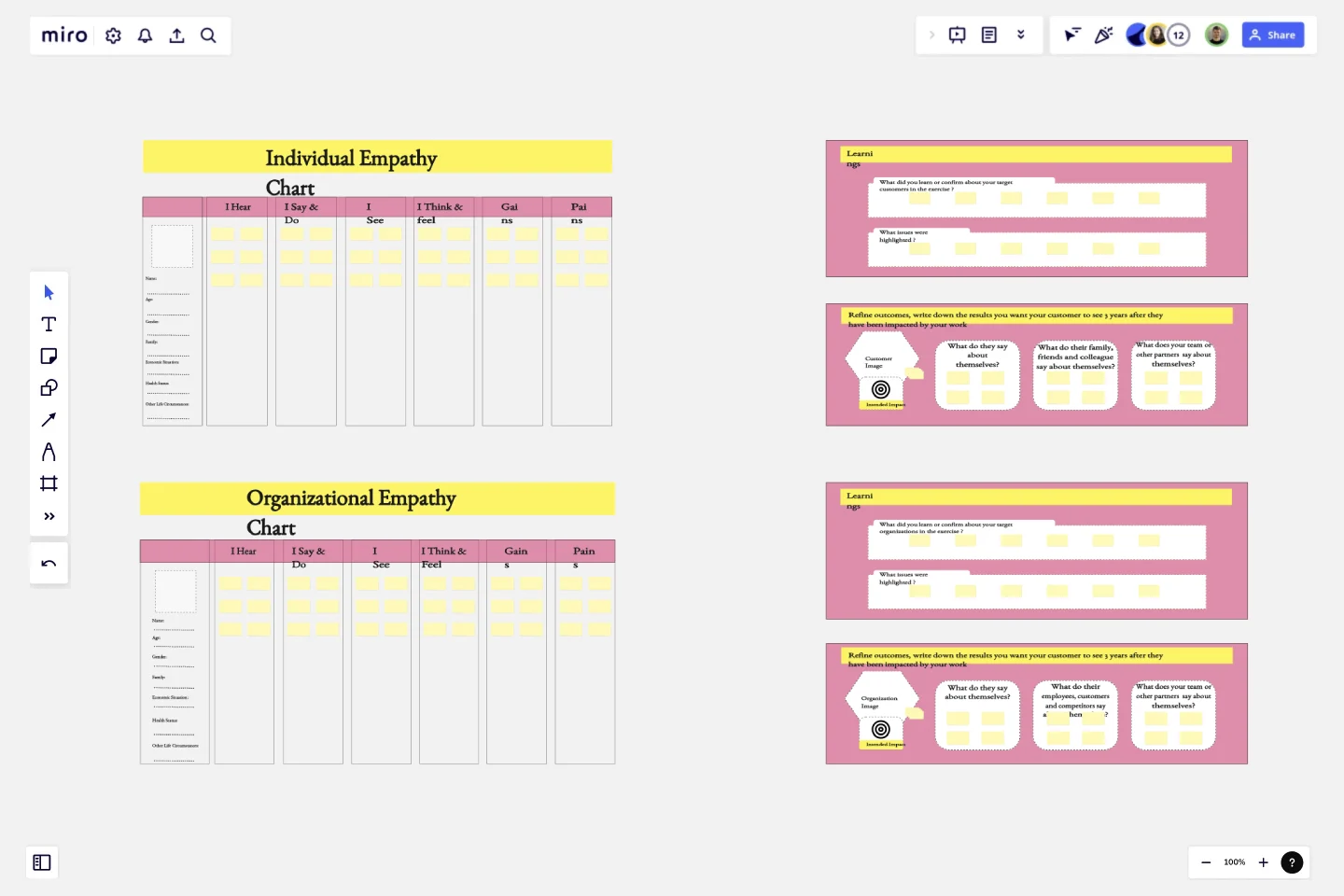Empathy Map by Aremu Dominion
Fill Out the Map/Table: Use our intuitive template to organize information into four key sections: "Says," "Thinks," "Feels," and "Does."What is an Empathy Map?
Explore the intricate landscape of your audience's thoughts, feelings, and motivations with our meticulously crafted Empathy Map template. Designed to illuminate the elusive realm of user experience, this tool offers a structured approach to understanding your users on a deeper level.
Benefits of an Empathy Map
Unlock the power of empathy and transform your understanding of your audience into actionable insights. Here’s how our Empathy Map template can revolutionize your strategy:
- Insightful Understanding: Gain profound insights into your users' desires, challenges, and aspirations.
- Enhanced Communication: Foster better communication and alignment across teams by creating a shared understanding of user needs.
- Informed Decision-Making: Make informed decisions based on real user data and emotions.
- Innovative Solutions: Inspire innovation by uncovering new opportunities and pain points.
- User-Centric Design: Create products and services that resonate deeply with your target audience.
How to Use an Empathy Map to Get the Best Results
Follow these steps to maximize the effectiveness of our Empathy Map template:
1. Define Your Persona: Start by identifying the persona (user/organization) segment you want to understand better.
2. Collect Data: Gather qualitative data through interviews, observations, or surveys to populate your Empathy Map.
3. Fill Out the Map/Table: Use our intuitive template to organize information into four key sections: "Says," "Thinks," "Feels," and "Does."
4. Identify Insights: Analyze the completed Empathy Map to uncover patterns, contradictions, and emotional triggers.
5. Prioritize Actions: Based on your insights, prioritize actions that address the most critical user needs or pain points.
6. Iterate and Improve: Continuously update your Empathy Map as you learn more about your users, ensuring ongoing relevance and accuracy.
Discover a deeper connection with your audience and elevate your strategy with our Empathy Map template. Start transforming user understanding into strategic advantage today!
This template was created by Aremu Dominion.
Get started with this template right now.
Kanban Framework Template
Works best for:
Kanban Boards, Agile Methodology, Agile Workflows
Optimized processes, improved flow, and increased value for your customers — that’s what the Kanban method can help you achieve. Based on a set of lean principles and practices (and created in the 1950s by a Toyota Automotive employee), Kanban helps your team reduce waste, address numerous other issues, and collaborate on fixing them together. You can use our simple Kanban template to both closely monitor the progress of all work and to display work to yourself and cross-functional partners, so that the behind-the-scenes nature of software is revealed.
Official 5-Day Design Sprint
Works best for:
Design, Desk Research, Sprint Planning
The goal of a Design Sprint is to build and test a prototype in just five days. You'll take a small team, clear the schedule for a week, and rapidly progress from problem to tested solution using a proven step-by-step checklist. Steph Cruchon of Design Sprint created this template for Miro in collaboration with design sprint gurus at Google. This Design Sprint template is designed specifically for remote sprints so you can run productive and efficient sprints with colleagues around the world.
Customer Touchpoint Map Template
Works best for:
Desk Research, Product Management, Mapping
To attract and keep loyal customers, you have to truly start to understand them—their pain point, wants, and needs. A customer touchpoint map helps you gain that understanding by visualizing the path your customers follow, from signing up for a service, to using your site, to buying your product. And because no two customers are exactly alike, a CJM lets you plot out multiple pathways through your product. Soon you’ll be able to anticipate those pathways and satisfy your customers at every step.
The Hot Air Balloon Retrospective
The Hot Air Balloon is a simple activity for helping the team identify things that makes them move faster, and things that slow them down.
Service Blueprint Template
Works best for:
Desk Research, Operations, Market Research
The Service Blueprint template is a visual tool for designing and optimizing service experiences. It provides a structured framework for mapping customer journeys, identifying touchpoints, and aligning internal processes. This template enables teams to visualize the entire service ecosystem, uncover pain points, and innovate solutions to enhance customer satisfaction. By promoting customer-centricity and collaboration, the Service Blueprint empowers organizations to deliver exceptional service experiences and drive sustainable growth.
Features Audit Template
Works best for:
Desk Research, Product Management, User Experience
Add new features or improve existing features—those are the two paths toward improving a product. But which should you take? A features audit will help you decide. This easy, powerful product management tool will give you a way to examine all of your features, then gather research and have detailed discussions about the ones that simply aren’t working. Then you can decide if you should increase those features’ visibility or the frequency with which it’s used—or if you should remove it altogether.
